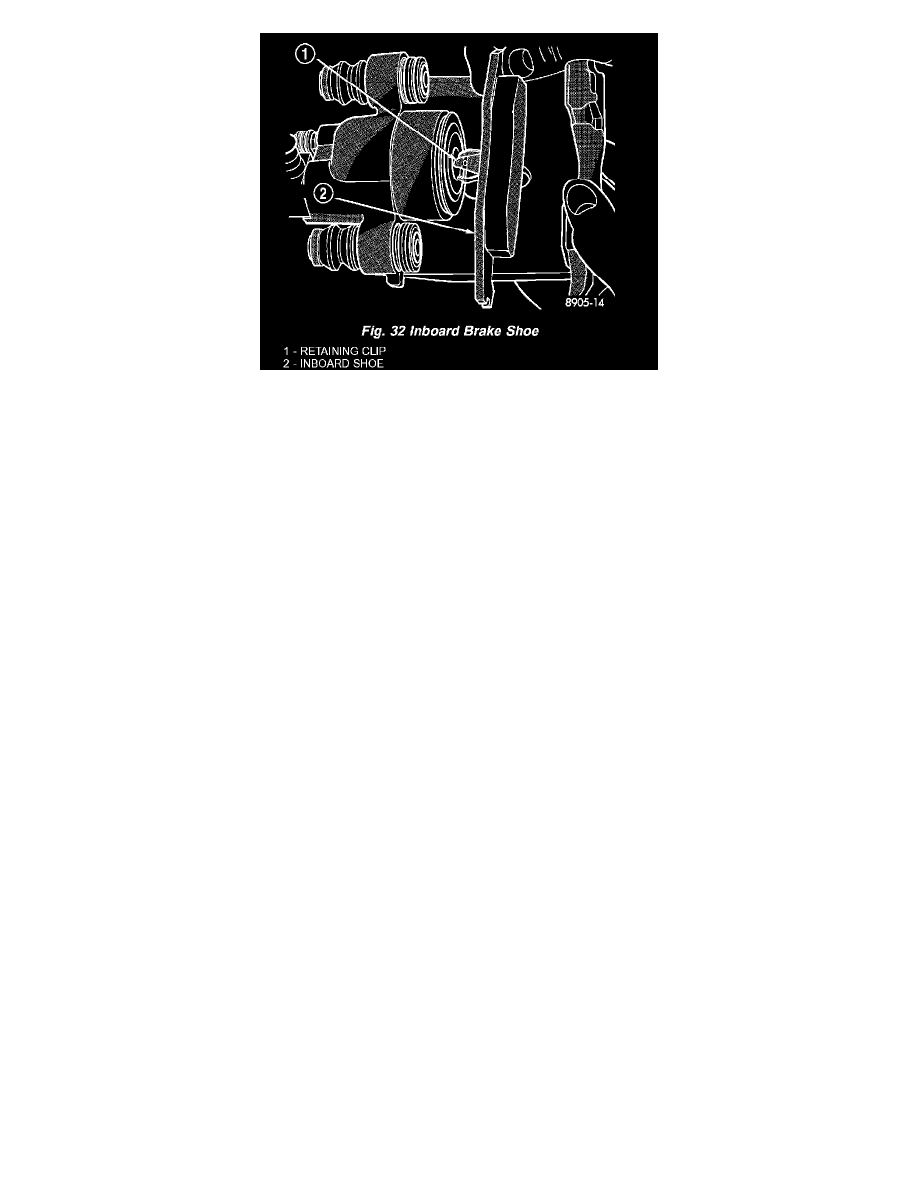SRT-4 L4-2.4L Turbo VIN S (2004)

7. Pull the inboard brake shoe away from caliper piston until the retaining clip is free from the cavity in the piston (Fig. 32).
CLEANING
WARNING: DUST AND DIRT ACCUMULATING ON BRAKE PARTS DURING NORMAL USE MAY CONTAIN ASBESTOS FIBERS
FROM PRODUCTION OR AFTERMARKET BRAKE LININGS. BREATHING EXCESSIVE CONCENTRATIONS OF ASBESTOS
FIBERS CAN CAUSE SERIOUS BODILY HARM. EXERCISE CARE WHEN SERVICING BRAKE PARTS. DO NOT SAND OR GRIND
BRAKE LINING UNLESS EQUIPMENT USED IS DESIGNED TO CONTAIN THE DUST RESIDUE. DO NOT CLEAN BRAKE PARTS
WITH COMPRESSED AIR OR BY DRY BRUSHING. CLEANING SHOULD BE DONE BY DAMPENING THE BRAKE
COMPONENTS WITH A FINE MIST OF WATER, THEN WIPING THE BRAKE COMPONENTS CLEAN WITH A DAMPENED
CLOTH. DISPOSE OF CLOTH AND ALL RESIDUE CONTAINING ASBESTOS FIBERS IN AN IMPERMEABLE CONTAINER WITH
THE APPROPRIATE LABEL. FOLLOW PRACTICES PRESCRIBED BY THE OCCUPATIONAL SAFETY AND HEALTH
ADMINISTRATION (OSHA) AND THE ENVIRONMENTAL PROTECTION AGENCY (EPA) FOR THE HANDLING, PROCESSING,
AND DISPOSING OF DUST OR DEBRIS THAT MAY CONTAIN ASBESTOS FIBERS.
INSPECTION
Visually inspect brake shoes (pads) for uneven lining wear. Also inspect for excessive lining deterioration. Check the clearance between the tips of the
wear indicators on the shoes (if equipped) and the brake rotors.
If a visual inspection does not adequately determine the condition of the lining, a physical check will be necessary. To check the amount of lining
wear, remove the disc brake shoes from the calipers.
Measure each brake shoe. The combined brake shoe and its lining material thickness should be measured at its thinnest point.
For rear disc brake shoes, when a set of brake shoes are worn to a thickness of approximately 7.0 mm (9/32 inch), they should be replaced.
Replace both disc brake shoes (inboard and outboard) on each caliper. It is necessary to replace the shoes on the opposite side of the vehicle as well as
the shoes failing inspection.
If the brake shoe assemblies do not require replacement, be sure to reinstall the brake shoes in the original position they were removed from.
INSTALLATION
CAUTION: When installing new brake components, be sure to use correct parts. Parts designed for BR3 Performance Brake System must not be
mixed with other brake systems. These parts, similar in appearance, can be easily identified.
NOTE: Perform Step 1 through Step 8 on each side of vehicle to complete shoe set installation, then proceed to Step 9.
1. Completely retract the caliper piston back into piston bore of the caliper. This is required to gain the necessary shoe-to-rotor clearance for the
caliper installation onto the steering knuckle.
2. Remove any protective paper from the noise suppression gasket on both inner and outer brake shoe assemblies (if equipped).
3. Install the inboard brake shoe into the caliper piston by firmly pressing the shoe in with the thumbs (Fig. 32). Be sure the inboard brake shoe is
positioned squarely against the face of the caliper piston.
4. Slide the outboard brake shoe onto the caliper assembly (Fig. 31). Be sure the retaining clip is squarely seated in the depressed areas on the
caliper.
